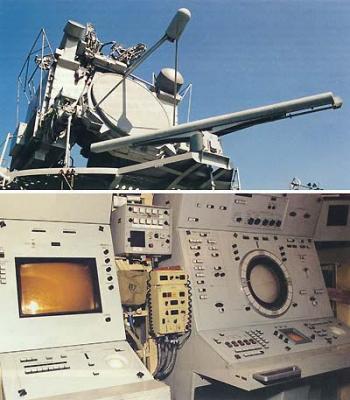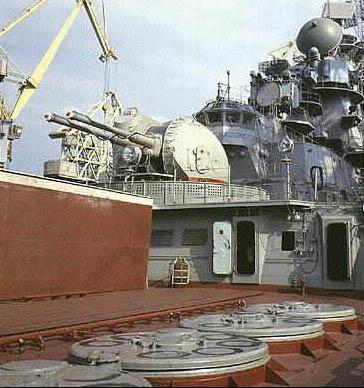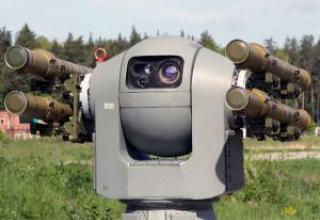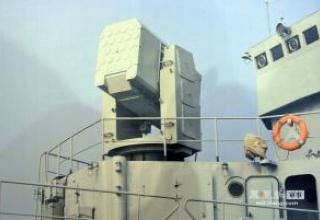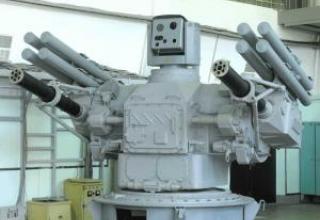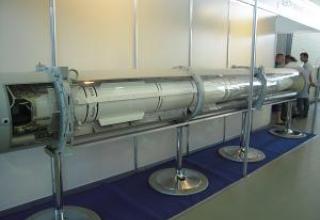Dagger" SAM system is a multi-channel, all-round, autonomous anti-aircraft missile system of close protection, capable of repelling the massive raid of low-flying anti-ship, anti-radar missiles, guided and unguided bombs, aircraft, helicopters, etc. Capable of operating on surface ships and screenplans of the enemy. It is installed on ships of various classes with a displacement of more than 800 tons.
The main developer of the complex - NPO "Altair" (chief designer - S.A. Fadeev), anti-aircraft missile - ICBM "Torch".
The ship-based tests of the complex were started in 1982 on a small anti-submarine ship at the Black Sea, Ave. 1124. During the demonstration firing in spring 1986, 4 P-35 cruise missiles were launched from coastal installations at the IGC. All P-35s were shot down by 4 Dagger SAM missiles. The tests were difficult and with the failure of all the deadlines. For example, the Dagger was supposed to arm TAKR Novorossiysk, but it was adopted with "holes" for the Dagger. On the first ships of the 1155 project the complex was installed one instead of the two.
Only in 1989, the "Dagger" SAM system was officially adopted for service of large anti-submarine ships on the Ave. Only in 1989, the Dagger SAM system was officially adopted for service of large antisubmarine ships at 1155 Ave., on which 8 modules for 8 missiles were installed.
At present, the Dagger SAM system is in service with the Admiral Kuznetsov heavy air carrier cruiser, Peter the Great nuclear missile cruiser (pr. 1144.4), large anti-submarine ships pr. 1155, 11551 and the newest patrol ships of the "Undaunted" type.
The "Dagger" air defense complex is offered to foreign buyers under the name "Blade".
In the west, the complex was designated SA-N-9 GAUNTLET.
Composition:
The complex uses a tele-controlled anti-aircraft missile 9M330-2, unified with missiles 9M330 and 9M331 (see description) of ground-based anti-aircraft systems "Tor" and "Tor-M1". 9M330-2 is made according to the aerodynamic scheme "duck" and uses a freely rotating wing block with folding wings. Launch ZUR - vertical under the action of a catapult with further declination of the missile gas-dynamic system, with which less than one second, in the process of climbing to the start height of the marching engine, the missile is turned towards the target.
Shrapnel-type warheads are detonated on command by an impulse radio detonator in the immediate vicinity of the target. The radio detonator is noise-proof and adapts when approaching the water surface. The missiles are placed in transport and launch containers and do not require inspection for 10 years.
The control system of the anti-aircraft missile system "Dagger" is designed for simultaneous use of the ship's missile and artillery weapons on any of the accompanied targets, includes a detection module that solves the following tasks:
- detection of air, including low-flying, and surface targets;
- simultaneous tracking of up to eight targets;
- analysis of the air situation with the setting of targets in accordance with the degree of danger;
- development of target designation data and issuance of data (by range, bearing and angle of position);
- issuance of target designation to the ship's air defense facilities.
Dagger" SAM system is equipped with its own radar detection equipment - K-12-1 module (see photo), which provides the complex complete independence and operational actions in the most difficult conditions. The basis of multichannel complex are phased antenna arrays with electronic beam control and a fast computing complex. The main mode of operation of the complex is automatic (without the participation of personnel), based on the principles of "artificial intelligence".
Built-in in the antenna post television and optical means of target detection not only increases its interference immunity in the conditions of intensive radio interaction, but also allows the staff to visually assess the nature of the escort and target defeat. The radar facilities of the complex are developed at the Research Institute "Quant" under the leadership of V.I. Guz and provide a target detection range of 45 km at an altitude of 3.5 km.
The "Dagger" can simultaneously fire up to four targets in the 60° space sector at 60°, with up to 8 missiles being launched in parallel. The reaction time of the complex is from 8 to 24 seconds, depending on the mode of the radar. In addition to SAM, the Dagger fire control system can control the fire of 30 mm AK-360M assault rifles, producing mature targets at a distance of up to 200 meters.
The 4C95 launcher of the Dagger complex was developed by the Start Design Bureau under the supervision of Chief Designer A.I. Yaskin. PU sub-deck, consists of 3-4 drum-type launch modules, each - 8 TPK with missiles. The weight of the module without missiles is 41.5 tons, covering an area of 113 square meters.
Characteristics:
| Range, km | 1.5 - 12 |
| Impact height of targets, m | 10 - 6000 |
| Speed of targets affected, m/s | up to 700 |
| Number of simultaneously fired targets | up to 4 |
| Number of simultaneously guided LSDs | up to 8 |
| Reaction time on a low-flying target,s | 8 |
| Shooting speed, s | 3 |
| It's time to put the compound on alert: | |
| from the cold, min | not more than 3 |
| from duty, s | 15 |
| ZUR Boeepage | 24-64 |
| Weight of the ZUR, kg | 165 |
| Weight BC, kg | 15 |
| The mass of the complex, t | 41 |
| The personnel, man. | 8 |
| Range of target detection at an altitude of 3.5 km (during autonomous operation), km | 45 |
| CLINOC SAM | |
| Number of simultaneously fired targets, pcs. | 4 |
| Number of starter modules, pcs. | 3-16 |
| Number of rockets on the launch module | 8 |
| Type of missile used | 9M330E-2, 9M331E-2 |
| Range of fire, km | 12 |
| Height of target target min/max., m | 10/6000 |
| Maximum target speed, m/s | 700 |
| The reaction time, s | from 8 to 24 (depending on the operating mode of the detection radar) |
| Number of channels per target, pcs. | 4 |
| Number of channels by missile, pcs. | 8 |
| Ammunition, pcs. | 24-64 |
| Dimensions and weight characteristics: | |
| complex weight (without ammunition), t | 41 |
| area (required), m2 | 113 |
| rocket weight (launch) 9M330E, kg | 167 |
| BC mass with ZSD, kg | 15 |
Testing:
One of the first carriers of the complex is a multipurpose nuclear submarine of the project 885 "Ash", which belongs to the fourth generation of submarines. The keelmark in the series, called "Severodvinsk", took place on December 21, 1993. The boat carries 24 missiles in inclined launch shafts. The natural model of the new anti-ship missile in an export version (a variant for underwater, surface and shore-based), was first publicly demonstrated at the exhibition MAKS-97. It was also exhibited at MAKS-99.
The advertising passport for the small rocket ship of project 21632 "Tornado" (approved on 26.04.2008) indicates the possibility of placing the Yakhont complex as one of the weapon variants.
According to military analysts' forecasts, the Yakhont complex will have no analogues in the world for another 10 years. This can be proved by the interest expressed by foreign buyers. A number of countries of the Asia-Pacific region, the Middle East, which in the past bought Russian ships and boats with cruise missiles, have already become interested in the novelty of the domestic military industrial complex. PCR Yakhont also has good prospects in terms of upgrading foreign-built ships, where it can replace the Harpoon, Exocet, and Otomat anti-ship complexes.
Sources:
- А.Широкорад "Ракеты над морем", журнал "Техника и Оружие" №5, 1996.
- Петров А. М., Асеев Д. А., Васильев Е. М. и др. "Оружие российского флота 1696-1996 гг." СПб: Судостроение
- А.В. Карпенко "Российское ракетное оружие 1943-1993". Санкт-Петербург, "ПИКА", 1993
- Зенитные ракетные комплексы ПВО СВ. Техника и вооружения №5-6.99
- В.П. Кузин "Атомные ракетные крейсеры проекта 1144". Тайфун
- Рекламный буклет. Продукция военного назначения для ВМФ. ГСКБ АЛМАЗ-АНТЕЙ. - С. 12-13. Распространялся на Выставке вооружений "Оборонэкспо 2014" в рамках Форума "Технологии в машиностроении", прошедшей с 13 по 17 августа 2014 года на территории Лётно-испытательного полигона имени М.М.Громова (Россия, Московская область, г.Жуковский).

